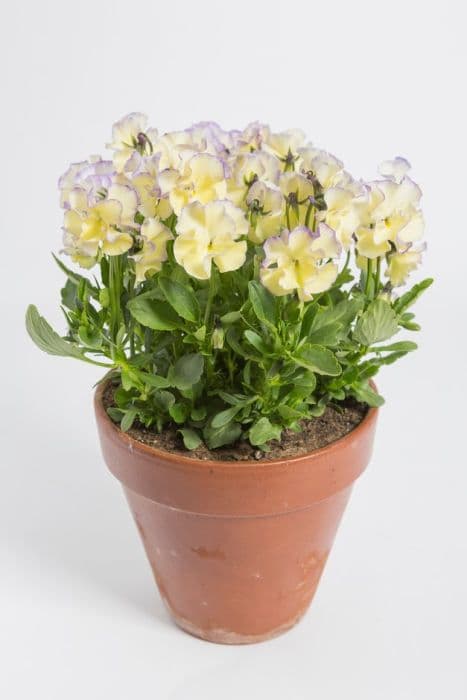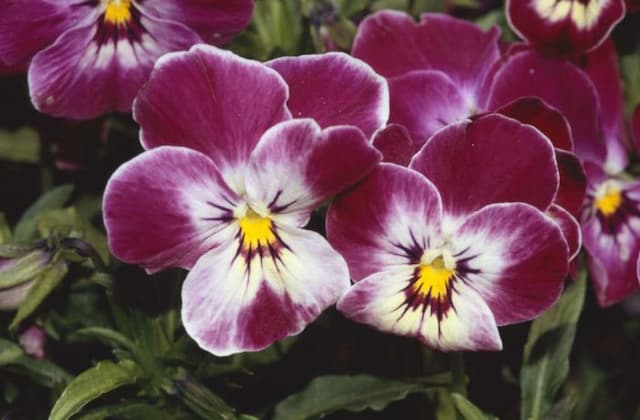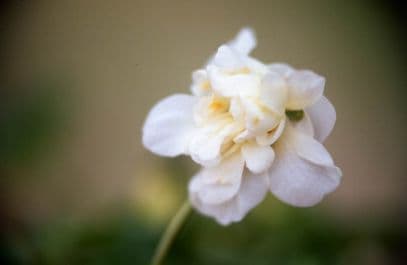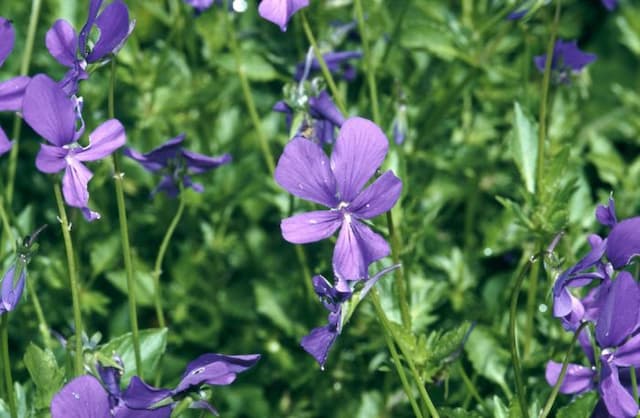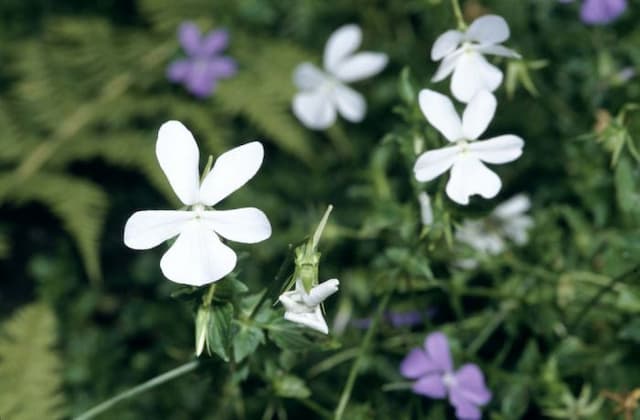Labrador Violet Viola labradorica ambig.

ABOUT
The plant commonly known as the Labrador violet has a distinctive appearance marked by its heart-shaped leaves that showcase a rich, dark purple hue, which sometimes appears so dark that it can be almost mistaken for black. In contrast to the dramatic leaf color, the flowers of this plant provide a striking display with their bright purple coloring. The petals are delicate and velvety, often exhibiting a lighter or white center that adds to the beauty of the overall bloom. The leaves are generally slightly ruffled or crinkled along the edges, adding texture to the foliage. The plant can give the impression of a lush, colorful mat due to its growth habit and the way in which its leaves and flowers cover the area where it is planted.
About this plant
 Names
NamesFamily
Violaceae
Synonyms
Labrador Violet, Alpine Violet, American Dog Violet, Labrador Dog Violet
Common names
Viola riviniana Rchb., Viola conspersa Rchb.
 Toxicity
ToxicityTo humans
Labrador violet is generally considered non-toxic to humans and is not known to have any adverse effects if ingested in small quantities. There are no commonly reported symptoms of poisoning from the ingestion of Labrador violet.
To pets
Labrador violet is also generally considered non-toxic to pets such as dogs and cats. If a pet were to ingest this plant, there are no specific toxicity symptoms or consequences that are widely recognized or reported for Labrador violet.
 Characteristics
CharacteristicsLife cycle
Perennials
Foliage type
Deciduous
Color of leaves
Purple-green
Flower color
Violet
Height
0.5 feet (15 cm)
Spread
1 feet (30 cm)
Plant type
Herb
Hardiness zones
4
Native area
North America
Benefits
 General Benefits
General Benefits- Ground Cover: Viola labradorica, commonly known as Labrador Violet, efficiently covers ground areas, preventing soil erosion and suppressing weeds.
- Aesthetic Appeal: With its heart-shaped leaves and charming purple flowers, Labrador Violet adds visual interest to gardens and landscapes.
- Low Maintenance: Labrador Violet requires minimal care, making it an easy addition for gardeners of all skill levels.
- Drought Tolerance: Once established, it's capable of withstanding periods of low water, making it suitable for drought-prone regions.
- Wildlife Habitat: The flowers of Labrador Violet provide nectar for pollinators such as bees and butterflies, supporting ecosystem health.
- Cold Resistance: Being naturally cold-hardy, it survives well in cooler climates and can endure frost.
- Shade Tolerance: Labrador Violet can grow in shaded areas where other plants might struggle, making it versatile for different garden spots.
 Medical Properties
Medical PropertiesThis plant is not used for medical purposes
 Air-purifying Qualities
Air-purifying QualitiesThis plant is not specifically known for air purifying qualities.
 Other Uses
Other Uses- Decorative Ice Cubes: The small flowers of the Labrador Violet can be frozen within ice cubes to create an attractive embellishment for cold beverages at special events.
- Edible Flower Garnish: The flowers of the Labrador Violet can be used as a colorful, edible garnish on salads, desserts, and cakes, adding a subtle floral flavor.
- Dye Production: Historically, the leaves and flowers could be used to produce a green dye for coloring textiles or craft materials.
- Photography: The vibrant colors of Labrador Violet make it an excellent subject for photographers specializing in flora and macro imagery.
- Pressed Flower Art: The flowers, due to their small size and striking color, are ideal for creating pressed flower art like bookmarks or decorative cards.
- Natural Confetti: Dried petals of the Labrador Violet can serve as biodegradable confetti for outdoor celebrations, reducing environmental impact.
- Fairy Gardens: Their petite nature makes Labrador Violets perfect for miniature fairy gardens, contributing to an enchanted aesthetic.
- Plant Tattoos: Artists may use the likeness of the Labrador Violet to create plant-themed tattoos, symbolizing faithfulness and a myriad of other meanings attributed to violets.
- Education: Labrador Violets could be used in educational settings to teach children about plant biology and gardening at an early age.
- Culinary Experiments: Creative chefs might infuse syrups or sugars with the essence of Labrador Violet flowers for use in innovative recipes.
Interesting Facts
 Feng Shui
Feng ShuiThe Labrador Violet is not used in Feng Shui practice.
 Zodiac Sign Compitability
Zodiac Sign CompitabilityThe Labrador Violet is not used in astrology practice.
 Plant Symbolism
Plant Symbolism- Humility: The small stature and subtle coloring of Labrador Violet often symbolizes modesty and humility.
- Innocence: Labrador Violet, like many other violets, is associated with innocence and purity, reminiscent of the flower's delicate nature.
- Spiritual Wisdom: Its springtime bloom is seen as a symbol of growth and enlightenment, conveying spiritual wisdom.
- Love and Affection: Throughout history, violets have been gifted to express love and tender affection, and Labrador Violet carries on that tradition.
 Water
WaterLabrador Violet should be watered regularly, providing consistent moisture without overwatering. Aim to keep the soil evenly moist, but not soggy. During active growth in spring and summer, water the plant approximately once a week with about one gallon of water, depending on climate and indoor conditions. In the cooler months, reduce watering slightly, but do not let the soil dry out completely. It's essential to ensure good drainage to prevent root rot.
 Light
LightLabrador Violets thrive best in partial shade to full shade. They should be placed in a spot where they receive filtered sunlight or only a few hours of morning sun, avoiding intense afternoon light. An ideal location is under trees that provide dappled shade or in a north-facing garden area where direct sunlight is limited.
 Temperature
TemperatureLabrador Violets prefer cool to moderate temperatures, ideally between 60 to 70 degrees Fahrenheit. They can tolerate temperatures down to 20 degrees Fahrenheit but should be protected from prolonged periods of extreme cold. They will perform best if not exposed to temperatures above 80 degrees Fahrenheit, so ensure a cool environment during hot summer months.
 Pruning
PruningPrune Labrador Violets to remove dead or yellowing leaves and spent flower stalks, which encourages new growth and more blooms. Pruning is best done in the spring or right after flowering to maintain plant shape and health. Occasional thinning of the foliage can also stimulate air circulation, reducing the potential for fungal diseases. Pruning every couple of months or as needed to keep up appearances is generally sufficient.
 Cleaning
CleaningAs needed
 Soil
SoilLabrador Violet prefers moist, well-draining soil rich in organic matter with a pH of 5.5 to 6.5. An ideal soil mix includes garden loam, peat moss, and perlite or sand to improve drainage.
 Repotting
RepottingLabrador Violet should be repotted every 1-2 years, in the spring, to refresh the soil and accommodate root growth.
 Humidity & Misting
Humidity & MistingLabrador Violet thrives best in average to high humidity levels, similar to its native woodland habitat.
 Suitable locations
Suitable locationsIndoor
Place in bright, indirect light and keep soil evenly moist.
Outdoor
Plant in partial shade, mulch around, and ensure soil stays damp.
Hardiness zone
3-8 USDA
 Life cycle
Life cycleViola labradorica, commonly known as the Labrador violet, begins its life as a seed, usually dispersed by ecological factors such as animals or water. Upon finding suitable moist and shady conditions, the seed germinates, and a small seedling emerges, developing a root system and a rosette of heart-shaped leaves. As the plant matures, it enters the vegetative stage, growing larger and producing more leaves, which are characterized by their purplish hue and are capable of photosynthesis, enabling the plant to gather energy from the sun. Once mature enough, the Labrador violet enters the reproductive stage, producing small, typically lavender to purple flowers with distinctive lower petals and a spur; these flowers are capable of self-pollination but also attract pollinators like bees and butterflies. After pollination, the flowers produce fruits, which are capsules containing seeds that are ejected from the parent plant to propagate the next generation. Finally, the plant may enter a period of dormancy during unfavorable seasons, typically winter, suspending growth until more favorable conditions return in the spring.
 Propogation
PropogationPropogation time
Spring to summer
Viola labradorica, commonly known as Alpine violet, is typically propagated through seed sowing. This is done by collecting seeds from the plant after the flowers have faded and the seed pods have dried. Once collected, the seeds can be sown directly into the soil in fall to allow a natural stratification period over the winter months, which encourages spring germination. However, for a controlled environment or if immediate planting is not feasible, stratification can be artificially done by placing the seeds in a moist medium such as sand or peat moss and then refrigerating them at a temperature of 35-40 degrees Fahrenheit (1.7-4.4 degrees Celsius) for 4-6 weeks. After stratification, the seeds can be sown in containers or flats with well-draining soil and lightly covered. The containers should be placed in a shaded area and kept consistently moist until seedlings emerge, which can take several weeks depending on the temperature and conditions. Once the seedlings are large enough to handle, they can be transplanted into their permanent positions.
